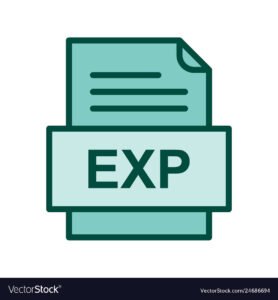If you’ve come across an exp file and found yourself puzzled about how to handle it, you’re not alone. EXP files, while not as commonly encountered as some other file types, serve important roles in various software applications and development environments. This step-by-step guide is designed to demystify EXP files for you, offering a comprehensive look at how to manage them effectively. Whether you’re looking to open, edit, or share an EXP file, this guide has got you covered.
Understanding EXP Files and Their Uses
EXP files, often referred to as Export files, serve a multifaceted purpose across various sectors. These files are essentially containers that hold data meant for export from one software application to another. In the realm of software development, EXP files are pivotal as they harbor exported symbols, functions, and objects critical for the linking process during software compilation. Such symbols may include references that other applications or files require to function seamlessly together.
In a completely different context, the world of embroidery also benefits from the utility of EXP files. Here, they encapsulate embroidery design information, enabling embroidery machines to accurately reproduce designs on fabric by reading these files. This dual utility underscores the versatility of EXP files, highlighting their importance in both technical and creative industries. Their role in facilitating the smooth transition of data or design elements across different platforms or devices makes them an indispensable asset in their respective fields.
Preparing Your Computer to Handle EXP Files
To effectively work with EXP files, it’s crucial to first ensure your computer has the right tools for the job. This preparatory step involves a few key actions based on the EXP file’s nature—be it for software development or embroidery design.
Start by determining the specific type of EXP file you have at hand. For those linked to software development, this might entail identifying the compatible integrated development environment (IDE) or compiler. Conversely, for embroidery-related EXP files, locating suitable design software is necessary.
Next, proceed to download and install the software that matches your EXP file’s requirements. Pay close attention to compatibility with your operating system to prevent any hitches. It’s also wise to verify that the software version you’re installing supports the EXP file version you intend to work with.
Finally, updating your system and the newly installed software to their latest versions can significantly reduce the risk of encountering compatibility or functionality issues. This step is often overlooked but can make a substantial difference in how smoothly you can handle EXP files on your computer.
Opening and Viewing EXP Files
To begin viewing the contents of an EXP file, first locate it within your computer’s directory. After finding the file, right-click on it to access the context menu and select the “Open with” option. This action prompts you to select the pre-installed software that corresponds to the type of EXP file you’re handling. If the necessary program isn’t immediately visible in the list, you’ll have the option to search for it on your computer. Upon opening the file with the chosen application, you will be presented with its contents.
For EXP files related to software development, this typically includes a series of symbols or pieces of code integral to the project. On the other hand, if dealing with an embroidery EXP file, a graphical representation of the design will be displayed, showcasing the intricate patterns and stitch types used. This process ensures you can successfully access and review the information contained within any EXP file, readying you for any further actions you may need to take, be it editing or sharing the file with others.
Editing and Modifying EXP Files
When you’re ready to make alterations to an EXP file, the process will vary based on its purpose. After opening the file in the relevant application, navigate to the editing interface. For developers working with software-related EXP files, this might mean tweaking code snippets or adjusting exported symbols crucial for application functionality. Embroidery enthusiasts will find options to modify design aspects such as color schemes, stitch patterns, or overall layout within their embroidery software.
1. Identify the specific toolset or editing features provided by your application. This could range from text-based code editors in development environments to graphical design tools in embroidery software.
2. Proceed with your edits, keeping in mind the potential implications of your changes. In the context of software development, altering symbols or functions could impact interoperability or functionality across different modules. For embroidery designs, adjustments may affect the final appearance or the feasibility of the design on actual fabric.
3. Once satisfied with your modifications, opt to save your work. Consider saving the modifications as a separate file to maintain the integrity of the original document. This practice ensures you have a fallback option in case revisions do not produce the expected outcome or compatibility issues arise post-editing.
Exporting and Sharing EXP Files
When it comes time to export or distribute your EXP file, the process can be streamlined with a few simple steps. Firstly, utilize the “Save As” or “Export” feature within your software application to save the EXP file in its current form or convert it into a different file format that suits your project’s requirements. This flexibility allows for broader compatibility across different platforms and software.
In the context of sharing, consider the technical environment of your recipient. It’s crucial they have access to, or can easily obtain, the appropriate software necessary to open and interact with the EXP file. To facilitate the sharing process, opt for email, cloud-based storage solutions, or dedicated file-sharing services. For larger EXP files that might be cumbersome to transfer, compressing the file into a ZIP format before sending can alleviate these issues, ensuring a smoother delivery and download experience for your recipient.
By attentively following these steps, you can efficiently export and share EXP files, guaranteeing that your projects move forward without unnecessary hindrances, whether they involve complex software development tasks or intricate embroidery designs.
